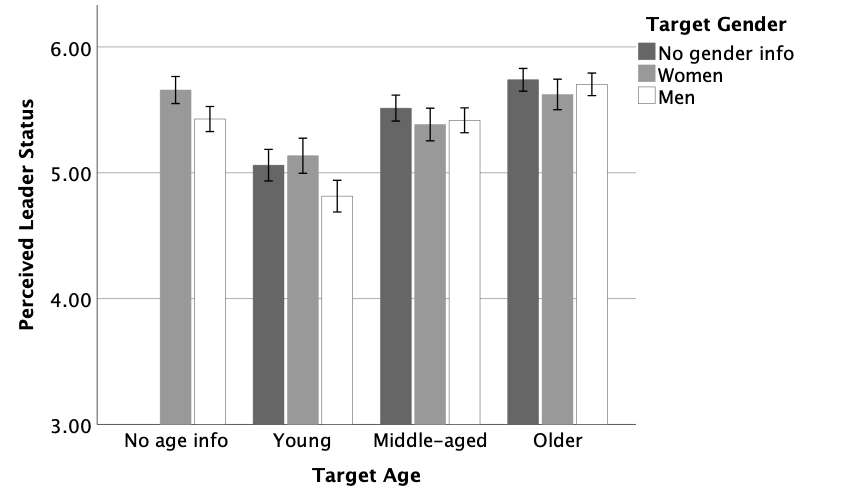An Intersectional Lens on Young Leaders: Bias Toward Young Women and Young Men in Leadership Positions

Young leaders, particularly those in prominent managerial positions, often find that their age is at the forefront of how they are perceived. Similarly, women in leadership roles frequently find their gender to be the focal point. Focusing on a leader’s young age or female gender can lead to negative biases and devaluation. For example, the leadership style of young leaders is sometimes evaluated more critically than that of their older counterparts. A participative leadership style, which involves consultation and joint decision-making, may be seen as a sign of insecurity and inexperience when exhibited by young leaders. In contrast, this same style is often perceived positively in older leaders.
While age discrimination and age biases in the workplace have been well-documented to older individuals, the challenges and barriers faced by young individuals, particularly in leadership roles, should not be underestimated. The question arises: What scientific insights exist regarding age-related bias toward young leaders?
Research on Young Leaders
The devaluation of young leaders due to their age is a complex and multifaceted issue. It can be partly attributed to status and role incongruity, which is rooted in the mismatch between age stereotypes and leader role expectations. Key qualities of a successful leader—such as competence, experience, and empathy—are often at odds with the stereotypes toward young individuals as being inexperienced, and self-centered. This mismatch between age stereotypes and leader roles may lead to greater expectations of failure for young leaders. While research has found no evidence that young leaders are indeed less effective or successful than middle-aged or older leaders, age stereotypes toward young adults might contribute to the underrepresentation of young individuals in leadership roles and negatively impact their perceived competence.
One study shows that a young leader’s age negatively affects acceptance and team dynamics, resulting in higher team turnover. The study differentiates between directive and participative leadership styles. While older leaders are accepted using both approaches, applying directive leadership behavior improves the situation for young leaders. However, participative leadership behavior, such as power-sharing, is perceived as less effective when implemented by young leaders. This indicates that young leaders should strategically select their leadership style to gain acceptance and reduce turnover. Other research highlights the negative consequences of biases against young adults in leadership roles. Young leaders often face negative attitudes from older employees, encounter higher demands yet have less access to resources, or develop a more negative self-image.
The age biases against young leaders are similar to biases against female leaders. In other words, the experiences of young leaders mirror those of women in similar positions, who grapple with the mismatch between gender stereotypes, their ascribed lower status, and the expectations of their professional roles as leaders. Specifically, women are often perceived as less assertive or dominant—attributes traditionally linked to leadership roles. Despite these findings, our understanding of how gender—the demographic characteristic most frequently examined in leadership research—affects or influences the age bias toward young leaders remains limited.
A New Study: An Intersectional Lens on Young Leaders
In our recent study, my co-authors Claudia Buengeler, Astrid Homan, and I examined the challenges young women and young men face in leadership roles. Considering both age and gender, this intersectional lens provides deeper insight into the unique challenges and barriers young leaders must navigate professionally. In psychology and management research, “intersectionality” refers to the simultaneous manifestation of biases and stereotypes affecting various group categories such as age, gender, race, sexual orientation, and social class. When these categories overlap, for example, in the case of young women, they can form a new category with its own set of biases and stereotypes, usually differing from those of the original categories.
Our study employed an intersectional lens to investigate age and gender biases in perceiving leaders’ status, including respect, esteem, and prestige. Specifically, we examined whether young female leaders face a “double jeopardy” due to the combination of young age and female gender, whether the bias is based solely on one of these factors, or whether they might escape bias by not being devalued on either factor (“intersectional escape”). Additionally, we aimed to determine whether, for young male leaders, their gender could offset a potential age bias, or whether any potential devaluation is primarily based on their young age.
To test our hypotheses, we conducted two pre-registered experiments with 1,903 participants in the USA. The methodology of these experimental studies, where we manipulated the leader’s age and gender, allowed us to analyze the effects of age, gender, and intersectionality separately.
In Study 2, our data collection was assisted by CloudResearch’s Connect platform, which enabled the efficient and convenient recruiting of participants for our experiment. The demographic targeting feature of CloudResearch’s Connect platform allowed us to collect a sample representative of the US population in terms of age, gender, race, and political orientation.
Our results show that people perceive young leaders as having lower status compared to middle-aged and older leaders, and this perception is consistent across genders. The data suggest that young age is potentially a more critical factor in the perception of leadership than gender, as indicated by the more substantial differences in perception across age groups (e.g., young women vs. middle-aged women) compared to within the same age group (e.g., middle-aged men vs. middle-aged women), as illustrated in Figure 1. This discrepancy may be due to the greater societal awareness and discourse surrounding gender discrimination, in contrast to age discrimination, which has not received as much attention yet.
Figure 1. Results for perceived leader status by target groups

Note. Error bars indicate standard errors. Age groups, both with and without gender information, are plotted on the x-axis. The dependent variable, perceived leader status, shown on the y-axis, was measured using four items that indicate perceptions of leader status, respect, prestige, and prominence.
Practical Implications: How Can We Counteract Age and Gender Bias?
Recent research indicates that even the slight differences in treatment based on stereotypes can have major impacts, affecting not just binary decisions like promotions or layoffs but also cumulative aspects like compensation. The perceived lack of experience and lower status ascribed to young employees can hinder access to leadership positions and lead to biased evaluations that do not reflect their abilities and qualifications. To minimize these biases, we recommend implementing the following measures:
Choose the Right Leadership Style: Young leaders often lean towards a participative style to shield them against criticism. However, this can lead to envy, mistrust, and skepticism about their leadership quality, especially early in their careers. To overcome these challenges and gain acceptance in the team, it is advisable to initially adopt proven, prototypical leadership styles that meet the expectations of the respective team, like a rewarding leadership style. Assigning clear tasks and responsibilities to team members and communicating your visions and concrete steps are also effective strategies. This approach allows young leaders to demonstrate competence and trustworthiness, leading to judgments based on their abilities and achievements rather than their age.
Proactively Promote Diversity: Work environments characterized by diversity, where dealing with different age groups is normal, can help reduce the bias against young leaders. Such environments encourage the dismantling of prejudices and foster an inclusive culture. Therefore, introducing age-diverse teams should be integral to the HR strategy. This can be supported through targeted HR policies, inclusive recruitment strategies, and specialized training programs. The training could, for instance, heighten awareness of age stereotypes against young and older individuals and impart specific skills for an inclusive leadership style.
This blog post first appeared in the journal PERSONALquarterly as
Daldrop, C. (2023). Junge Führungskräfte: Abwertung aufgrund von Alter und Geschlecht am Arbeitsplatz. Personal Quarterly. (pdf)
You can read the full research article here.
Daldrop, C., Buengeler, C., & Homan, A. C. (2023). An intersectional lens on young leaders: Bias toward young women and young men in leadership positions. Frontiers in Psychology, 14. https://doi.org/10.3389/fpsyg.2023.1204547
References
Berdahl, J. L., & Moore, C. (2006). Workplace harassment: Double jeopardy for minority women. Journal of Applied Psychology, 91(2), 426–436. https://psycnet.apa.org/doi/10.1037/0021-9010.91.2.426
Buengeler, C., Homan, A. C., & Voelpel, S. C. (2016). The challenge of being a young manager: The effects of contingent reward and participative leadership on team-level turnover depend on leader age. Journal of Organizational Behavior, 37, 1224–1245. https://doi.org/10.1002/job.2101
Cole, E. R. (2009). Intersectionality and research in psychology. American Psychologist, 64, 170–180. https://doi.org/10.1037/a0014564
Daldrop, C., Buengeler, C., & Homan, A. C. (2023). An intersectional lens on young leaders: Bias toward young women and young men in leadership positions. Frontiers in Psychology, 14. https://doi.org/10.3389/fpsyg.2023.1204547
Eagly, A. H., & Karau, S. J. (2002). Role congruity theory of prejudice toward female leaders. Psychological Review, 109, 573–598. https://doi.org/10.1037/0033-295X.109.3.573
Francioli, S. P., & North, M. S. (2021). Youngism: The content, causes, and consequences of prejudices toward younger adults. Journal of Experimental Psychology: General, 150, 2591–2612. https://doi.org/10.1037/xge0001064
Hester, N., Payne, K., Brown-Iannuzzi, J., & Gray, K. (2020). On Intersectionality: How complex patterns of discrimination can emerge from simple stereotypes. Psychological Science, 31, 1013–1024. https://doi.org/10.1177/0956797620929979
Irehill, H., Lundmark, R., & Tafvelin, S. (2023). The well-being of young leaders: demands and resources from a lifespan perspective. Frontiers in Psychology, 14. https://doi.org/10.3389/fpsyg.2023.1187936
Kunze, F., & Menges, J. I. (2016). Younger supervisors, older subordinates: An organizational-level study of age differences, emotions, and performance. Journal of Organizational Behavior, 38, 461–486. https://doi.org/10.1002/job.2129
Martin, A. E., North, M. S., & Phillips, K. W. (2019). Intersectional escape: Older women elude agentic prescriptions more than older men. Personality and Social Psychology Bulletin, 45, 342-359. https://doi.org/10.1177/0146167218784895
Offermann, L. R., & Coats, M. R. (2018). Implicit theories of leadership: Stability and change over two decades. The Leadership Quarterly, 29, 513–522. https://doi.org/10.1016/j.leaqua.2017.12.003
Rosette, A. S., de Leon, R. P., Koval, C. Z., & Harrison, D. A. (2018). Intersectionality: Connecting experiences of gender with race at work. Research in Organizational Behavior, 38, 1–22. https://doi.org/10.1016/j.riob.2018.12.002
Rudman, L. A., Moss-Racusin, C. A., Phelan, J. E., & Nauts, S. (2012). Status incongruity and backlash effects: Defending the gender hierarchy motivates prejudice against female leaders. Journal of Experimental Social Psychology, 48, 165–179. https://doi.org/10.1016/j.jesp.2011.10.008
Walter, F., & Scheibe, S. (2013). A literature review and emotion-based model of age and leadership: New directions for the trait approach. The Leadership Quarterly, 24, 882–901. https://doi.org/10.1016/j.leaqua.2013.10.003
Zhang, T., & North, M. S. (2020). What goes down when advice goes up: Younger advisers underestimate their impact. Personality and Social Psychology Bulletin, 46, 1444. https://doi.org/10.1177/0146167220905221

